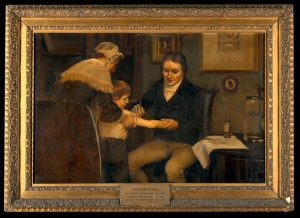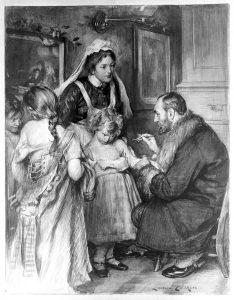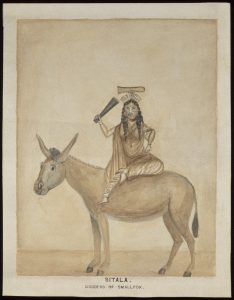The World Health Organisation (WHO) recently published statistics showing a 300% increase in European measles cases in 2017 compared to 2016, resulting in 21,000 cases and 35 deaths. The WHO director for Europe has said:
“Every new person affected by measles in Europe reminds us that unvaccinated children and adults, regardless of where they live, remain at risk of catching the disease and spreading it to others who may not be able to get vaccinated.”
Yet, despite the fact that one out of every 1,000 childhood measles cases develops encephalitis (swelling of the brain) that can leave children with a serious disability, vaccination rates for MMR (measles, mumps and rubella) dropped for the third year in a row, to 91.6%.
The main concern for parents is the safety of vaccines. Since Andrew Wakefield’s now retracted article regarding the link between MMR and autism was published in The Lancet in 1998, the reputations of vaccines have been severely tarnished. However, this is nothing new: doubts regarding vaccines have existed as long as the vaccines themselves. The Victorian period offers some particularly striking parallels with our own era, with the history of anti-vaccination telling an important tale about those with less financial and political influence and the power they have over their own bodies.

Dr Jenner performing his first vaccination, on James Phipps, a boy of 8, May 14 1796. Wellcome Collection.
It was nearly 60 years after Jenner’s first experimental vaccination in 1796 that the Vaccination Act of 1853 made the smallpox vaccine compulsory for all British children. The legislation had a clear impact on the death rate from smallpox, which fell from 304 deaths per million between 1841–53, to 132 per million after the Act was introduced. However, despite the falling death rate, the compulsory element of the Act caused uproar in Victorian society. Although the law made it compulsory for infants to be vaccinated, it was the poorer part of society that was particularly targeted. Almost 30 years after the Act was passed, there was still significant resistance to its compulsory nature. In March 1885, a demonstration took place in Leicester that attracted a crowd of around 80,000 people. The demonstrators marched with images of a child’s coffin, labelled “another victim of vaccination”.
By 1867, compulsory vaccination was more stringently upheld as public vaccinators were appointed and increased penalties for non-compliance were introduced. However, parents faced a further dilemma in the 1870s when Dr Robert Brudenell Carter suggested that by taking lymph from one person and inserting it into another one could transmit syphilis. Such findings provoked serious anxiety for parents who had to decide between a fine of 20 shillings (which could be repeatedly charged), or allowing their child to be injected with a potentially infected vaccine. Working-class families resented the fact that wealthier parents could easily pay the fine and avoid vaccination. Poorer parents even risked the state claiming their household possessions if they couldn’t pay, and some mothers and fathers were imprisoned for disobeying the Acts. The legislation seemed to sanction intrusion not only into working-class people’s lives but also their bodies.
It wasn’t just the working classes who objected to compulsory vaccination, however. Conservative Prime Minister Lord Salisbury widely criticised the Act towards the end of the nineteenth century – at least when it came to British citizens. Salisbury argued it was wrong to force vaccination onto freeborn British citizens as they had the right to refuse a vaccine, but he also argued that it was acceptable to use vaccines on ‘imperial subjects’ in Ceylon and India. Before vaccination was introduced in India, variolation was used. This method of inoculating an individual used live smallpox (rather than the cowpox used by Jenner) to produce a moderate form of the disease which would then protect the individual against subsequent attack. The smallpox vaccine, derived from animal matter, caused a particular problem for Hindus due to the violation of a sacred animal. This brought a religious element into the decision: should one be vaccinated against a deadly disease or violate a religious law? In introducing vaccination to India – though reducing the number of deaths caused by smallpox – the British government interfered in cultural and religious matters in its attempts to ‘change’ the bodies of its foreign subjects.
The Victorian anti-vaccinators and modern-day vaccine rejectors have two important arguments in common: the effectiveness of vaccines and the potential harm they may cause. Over the course of the nineteenth century, one of the main arguments that anti-vaccinationists used was the fact that vaccination did not provide lifelong protection from smallpox, as Jenner had claimed. Many modern rejectors of vaccines use the example of the flu vaccine to illustrate this lack of effectiveness, though the vaccine does reduce the risk of contracting influenza by 40-60%.
Today, the internet is awash with both conspiracy theories and genuinely worried parents. The American ‘natural health’ website Living Whole argues that ‘vaccinating a child is like taking a child out of their perfectly functioning car seat and strapping them into a seat with dental floss’. Besides conjuring up some rather strange imagery, opinions like this can cause real harm. In British society today, we have the choice whether or not to vaccinate our children. It is important that we consider not just individuals, however, but society as a whole – such as children who are unable to be vaccinated due to ill health (in, for example, leukemia). In 2017, the French government decided to return to compulsory vaccination due to falling vaccination rates, despite 30% of French people not trusting vaccines. However, instead of vilifying and ridiculing concerned parents, it is important that medical authorities specifically address the concerns that these families have. If history has taught us anything it is that only through listening to and addressing concerns – rather than using legislation forcing parents to vaccinate against their will – that attitudes towards vaccination will change.
Further reading
Alison Bashford, Imperial Hygiene: A Critical History of Colonialism, Nationalism and Public Health (New York: Palgrave Macmillan, 2004)
Nadja Durbach, Bodily Matters: The Anti-Vaccination Movement in England, 1853-1907 (Durham: Duke University Press, 2005)
Anna Kata, ‘A postmodern Pandora’s box: Anti-vaccination misinformation on the Internet’, Vaccine, 28:7 (2010)
Header image: MMR vaccine, United Kingdom, 1999. Science Museum, London.


